It's finally time to talk about LinuxTag 2010. It was my third time there, and this year was the best so far, at least for me! And that's most probably because of how amazing our openSUSE booth turned out to be! Or maybe it's because of the invasion of the Geekos?
openSUSE Booth
We certainly didn't have a big slot for out booth, but oh boy... it ended up big! Our booth was always filled with people, who, I guess, got attracted by the touchscreens we have. But attracting people is of no good if you can't get them interested. We did various demos on the touchscreens, but our small secret ingredient were the workshops: four times a day (and sometimes even more), people could sit down in our booth to participate in a session on various topics — those ranged from learning Inkscape, to creating your first package in the Build Service, via playing together with GNOME Shell. That really worked out well, especially at it helps getting the visitors more involved in the discussion.
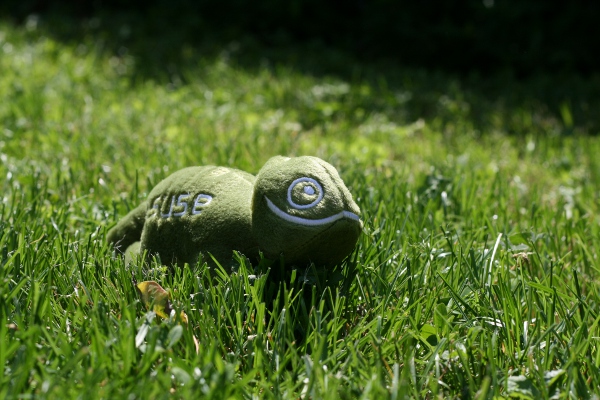
The world-famous Geeko
Many thanks to Jan (who had to suffer my presence way too much, I'm sure!) and Michael for the organization of our booth!
GNOME Presence
As mentioned in my previous post, there was no GNOME booth at the event. And it didn't go unnoticed: I met various people wondering about this. So I surely hope the German community will make sure it doesn't happen again next year!
Even without a booth, we managed to get a relatively good presence during the event. Of course, it was easy to stumble upon some GNOME people — our friends from Openismus, of course, but also Stormy, Lennart, Tobias and more. Some of us were giving a GNOME-related talk, and Stormy and I participated in a RadioTux interview, so our footprint was present :-)
Talks
I didn't attend many talks. Actually, I think I only attended Stormy's one — Stormy is good at making you raise your hand to keep you connected to what she says — and Lennart's talk about Surround Sound.
The talk Johannes and I gave went quite well, with around 50 people in the room, which is quite good since it was not a keynote and it was in English. We had good questions from the audience, which at least means they were not totally asleep ;-) Generally speaking, I'm nearly always pleasantly surprised by the reaction of people when they get to see GNOME Shell for the first time: I somehow always expect that I have to carefully explain some of the design decisions, but it's apparently unneeded. Most of the persons I meet are glad we're doing something different and seem to be ready to try the change!
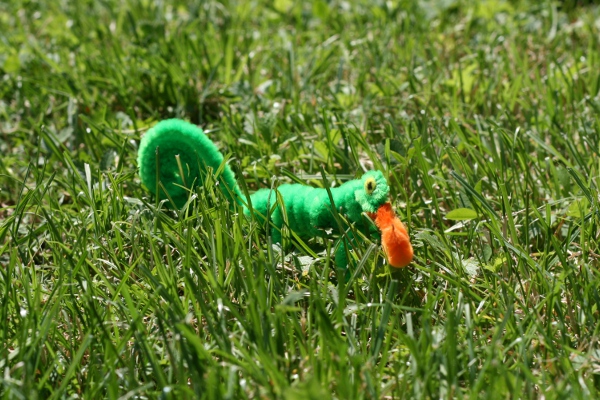
A wilder Geeko, built by yours truly
The live A-Z Guide to openSUSE Contribution was the second talk I was involved in, with Henne. With 26 letters in 30 minutes, you might think it's plenty of time. But we actually had to rush to talk about everything! The goal was really to show that there are tons of areas where people can contribute in openSUSE, while most people think it's just packaging. And 26 was our limit, but I'm sure we could have gone on and on for a long time: everyone can help (packaging, sure, but also presence at events, support, bug triage, helping with screencasts, contributing to a positive atmosphere inside the project, etc.). Most of our items were actually not specific to openSUSE and are common to most free software projects... I really like the format Henne found for the talk; that's something I'll keep in mind for future talks.
Meeting people
LinuxTag is also a great opportunity to sit down with a few people. We had both GNOME and KDE people (Stormy, Claudia, Frank and I) all sitting around a table to discuss the organization and the bids for Desktop Summit 2011. Thanks to our experience with GCDS, we have a good basis for the organization since we know what worked well and what didn't. We came out with an aggressive timeline to take a decision during this summer, which should help the organization team start the work early.
Johannes, Stormy and I also chatted about the GNOME developer tools and what we can do to improve our story there. That's something where the Foundation wants to help, but this can only happen if our community wants to improve them, of course. We wondered for a bit while our own developers don't use a tool like Anjuta. Is it just a matter of habits? Or is it missing some features? (I know that, in my case, I just can't live without vi-like keybindings...)
c-base
On Friday evening, the GNOME folks were invited to a barbecue organized by LXDE people at c-base. I had heard about c-base for quite some time, but it was a first for me. Lennart insisted that I should go through the main entrance to truly enjoy the experience, so Andre guided me there (okay, he nearly got lost ;-)). And indeed, I can only recommend that you do the same if you ever go to visit c-base. And I know for sure I'm human now!
The highlight of the evening was undoubtedly the learning of a new card game: skat. I watched people play, and it somehow felt a bit familiar; that's because it's somehow similar to belote (although it's also completely different, but well...). Tobias offered to teach me, and it all went well. I mean, it made sense. And then I was explained how the bidding works. I'm still trying to figure out why it works this way ;-) I understand how it works, but... it just feels totally arbitrary with no reason. I was glad that I managed to help Stormy and Kat learn it later on (well, Stormy had understood most of the rules already by watching the game). So we were three complete beginners playing skat at some point :-)
Attack of the Geekos
But the best thing about LinuxTag was the omnipresence of Geeko, the openSUSE chameleon. I must admit I enjoy Geeko, and that's something I sorely miss in GNOME: our GNOME foot is nice, but that's not the same. We should probably talk more about our beloved Rupert, I guess. (And I still don't have any Rupert at home, that's a tragedy for me!)
As seen in the pictures in this post, we had several versions of Geekos, and I managed to bring some of them home. One of the workshop we had everyday at the openSUSE booth consisted of creating your own Geeko-ified object: the wireframe Geeko was one of them, but people also had the opportunity to create a pin, a shopping bad and a magnet. You can recognize Henne's creative mind behind all this.
But that's not all, we had a balloon clown, who created tens of balloon Geekos:
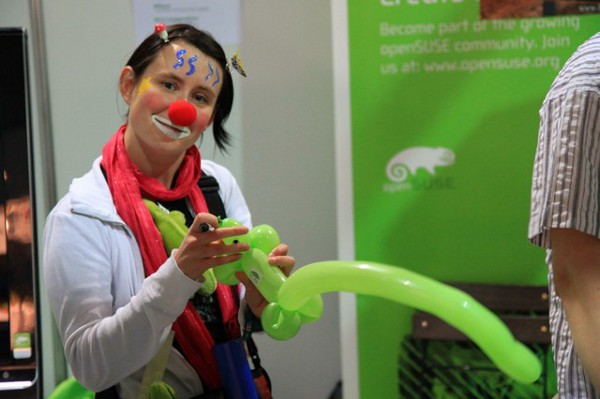
Our amazing balloon clown by Thomas Schmidt (see more pictures)
And the balloon Geeko can survive a flight trip, here's mine a few days after the event:
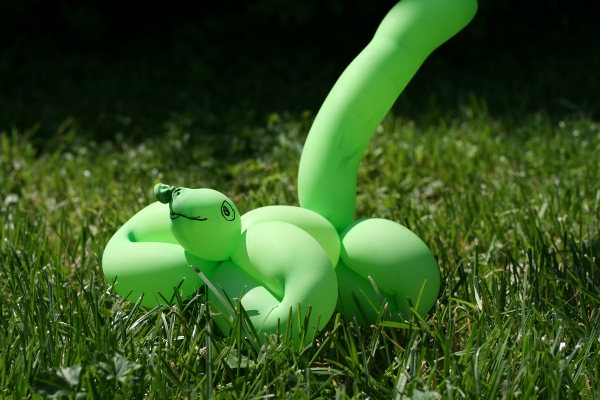
A light Geeko
The stuffed Geekos we had were highly-demanded: everybody loves it! And I understand, really: how can you not love it? At some point, I took 3 or 4 of them and hid them in various places in the venue. Actually, they were not really hidden, but integrated
: it just felt like they belonged there. And I'm sure it made some people smile ;-)
Yes, LinuxTag was big this year, and I'm happy that Novell let me go to the event! I hope you'll want to come next year, now :-)
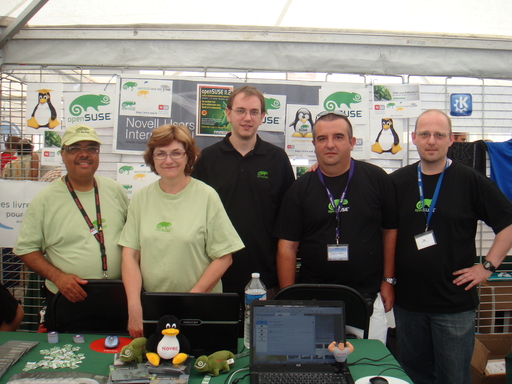
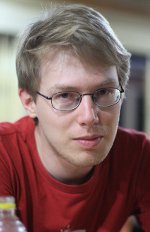
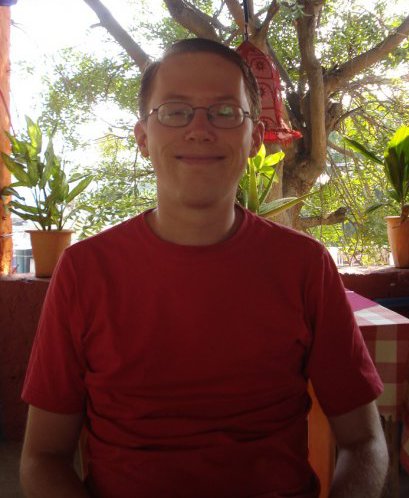




Last Comments